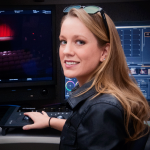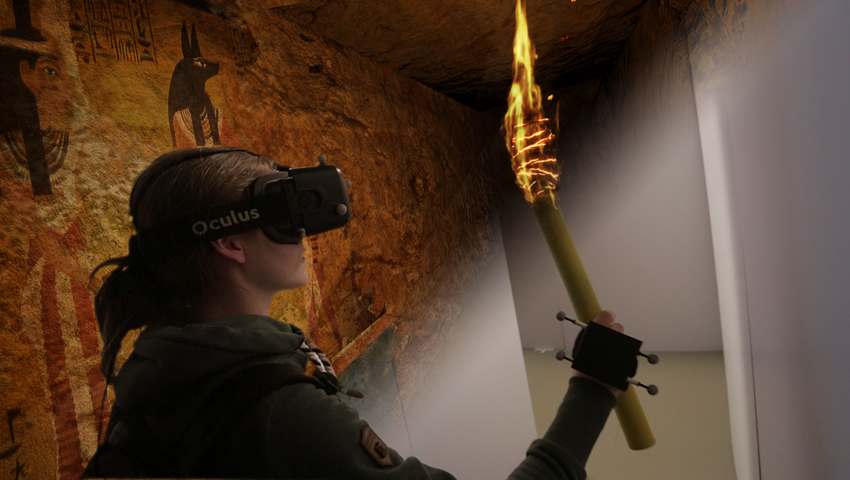Image: Real Virtuality: Immersive Explorer. Courtesy of Sylvain Chagué, Fondation Artanim; Bart Kevelham, Fondation Artanim
VR Village Chair Denise Quesnel shares her take of the evolution of virtual reality, from curiosity to commercial viability. The VR Village at SIGGRAPH 2016 will share the very leading edge of developments in the “VR revolution” and is now accepting content submissions. If you are a VR/AR and immersive format creator interested in submitting to VR Village, you are very welcome to demonstrate the full extent of your creativity and technical mastery! Share an abstract idea of what you are planning to present, coupled with some images and video to help the jury visualize your concept. The VR Village will have a stage and several areas on the floor where attendees can physically move inside an immersive environment, offering a unique place to try experiences previously limited to lab environments. Attendees will also be able to gain knowledge on VR topics through presentations by experts in Talks, Panels, and Courses.
by Denise Quesnel
With a plethora of bylines and media articles labeling 2016 the year of Virtual Reality, it is easy to feel overwhelmed (and possibly a bit cynical) towards a medium that has yet to become accessible on a commercial level. We may be going into uncharted territory this year, but there are a growing number of recognized characteristics that make virtual reality (VR) remarkable:
- it can generate potent emotions of empathy;
- it enables travel to virtually anywhere;
- it has “presence,” otherwise known as the moment when your body and mind believes itself to really be there in the virtual environment.
Despite these powerful attributes, like all new technological and creative developments, virtual reality will need to continue to win over our hearts and minds. This road will be traveled in 2016 when fine-tuned hardware and software finally lands in the hands of the general public.
It is important to note that for many, VR has been a mainstay tool for more than twenty years. For the majority of the planet’s inhabitants, however, the use of VR and augmented reality (AR) may appear to have come out of left field. Society at large has a fascinating relationship with new technology and the adoption of it. Technology adoption life cycles are well-documented sociologically, and in economic terms, the diffusion (or spread) of a new idea or technology is also measured. Many economists have pointed out that there is a paradox between the diffusion of technology and the importance it plays in society. In essence, until a volume of users adopts a new technology, it is unlikely to have a profound impact on our well being. Yet in order to innovate successfully, businesses, artists and academics require a degree of established users. Chicken, please meet egg.
The VR Revolution
Fortunately, what we have in VR isn’t simply an interactive consumer product, but a powerful, stunning medium capable of providing a complete sensory, physical and emotional experience. History is being made every day. One of the most exciting outcomes of the ‘VR revolution’ to date is the diversity of users and creators. The force behind the medium and tools are regular working folk involved in CG, gaming, storytelling, journalism and healthcare. In order to create a VR experience, there isn’t a massive investment in money or time required. This has allowed people working as artists and those in startups to match the quality of work being conducted in Hollywood studios and massive VFX/gaming departments. This was extremely apparent within SIGGRAPH 2015’s VR Village, where students, entrepreneurs, artists, developers and filmmakers at all levels demonstrated the possibilities of VR along side one another.
There has been a lot of press about the storytelling opportunities and features of interactivity in VR/AR. Through the use of a head mounted display and either controllers or gloves, users can interact with their virtual environment in a tactile, immersive manner. Some up and coming approaches to VR experiences build upon this and become multi-sensory experiences that take full advantage of the body and mind. Binaural audio, for example, is close to being embraced on a widespread scale as one of the most important immersion strategies of our time. But what about tapping into other physiologically modeled devices or bio-sensing technologies, like fitness wearables? Bio-sensing technology helps people to connect with themselves, each other and the world around them. VR coupled with multi-sensory experiences that use biofeedback or neuro-feedback can encourage compassion towards another being, and allow users to physically explore alternative spaces. These innovations are happening now and will have a huge impact on our well being once they become broadly available.
This all comes back to the sociological model of the diffusion process, where our lives become profoundly impacted by a new technology as its volume of users grows. The impact VR technology and content is poised to have on our social lives is key in addressing one of the main criticisms of VR technology – that VR is possibly isolating or provides an unhealthy escape from reality. At the risk of sounding overly philosophical, I would suggest that in rooting oneself in reality through the use of their own senses and being, a user isn’t necessarily escaping as much as they are exploring, or layering forms of reality. It is similar to our use of social media or telepresence (in the form of phone and in-person communication). Imagine collaborating virtually with other people in completing a mural or a sculpture? Or consider interacting inside a world with other people, using only your brain waves to control your environment? Additionally, as more of our communication happens non-verbally in day-to-day life, VR is a conduit for volumetric, tracked representations of our likenesses, which is incredibly compelling within a group dynamic.
VR at SIGGRAPH 2016
In the context of a trade show floor, where many people get their first glimpse of VR/AR, our technology and experiences may look isolating to an onlooker. This presents an interesting problem to solve for artists and developers who desire to show an experiential medium and tool in public. Some use a combination of theatre, VR, and projection mapping to include both performers and audience, and projects built in this manner frequently use motion capture technology/motion sensing input devices to track multiple individuals in real time inside a hybrid physical and virtual environment. At SIGGRAPH 2016, the Experience Hall will feature the return of VR Village, and this venue will feature experiences like those I have mentioned in this post: Attendees can expect to try out collaborative and interactive installations and theatrical presentations.
When it comes to considering the creative and innovative potential of immersive mediums, the technology already exists to create all sorts of experiences, and it is the integration of these technologies that enables a constant flow of innovative work. I like to consider that if an individual is capable of imagining and dreaming up an experience, there are few obstacles in the way now to not only create, but also become the experience in a physical, social and emotional manner. Virtual reality is a big step in realizing this potential, and is coming very soon to a virtual environment near you!
 Denise Quesnel is a researcher of immersive content creation and virtual reality, specific to post-production and R&D for VR, stereoscopic 3D, high frame rate, CAVE and Fulldome content. She has been working as a consultant in designing workflows for the VFX and film industry since 2007, and is a full-time researcher at Emily Carr University of Art + Design. She also works in a capacity as a research consultant, designing and executing experiments around cognition, perception, and brain-computer interfaces with immersion environments. This work frequently is in partnership with international collaborators, and she enjoys the experience of co-creating artistic content through these collaborations. She is the 2016 and 2017 SIGGRAPH VR Village Chair, co-creator of the Consortium for Future Reality with NYU’s Media Research Lab, co-founder of the Canada Chapter: Advanced Imaging Society, a contributor to the Immersive Technology Alliance, and board member of several CG, VR and S3D organizations around the world.
Denise Quesnel is a researcher of immersive content creation and virtual reality, specific to post-production and R&D for VR, stereoscopic 3D, high frame rate, CAVE and Fulldome content. She has been working as a consultant in designing workflows for the VFX and film industry since 2007, and is a full-time researcher at Emily Carr University of Art + Design. She also works in a capacity as a research consultant, designing and executing experiments around cognition, perception, and brain-computer interfaces with immersion environments. This work frequently is in partnership with international collaborators, and she enjoys the experience of co-creating artistic content through these collaborations. She is the 2016 and 2017 SIGGRAPH VR Village Chair, co-creator of the Consortium for Future Reality with NYU’s Media Research Lab, co-founder of the Canada Chapter: Advanced Imaging Society, a contributor to the Immersive Technology Alliance, and board member of several CG, VR and S3D organizations around the world.



